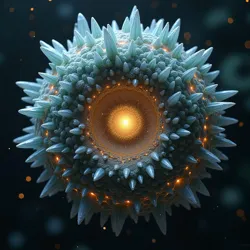Synthoid
A Synthoid is an advanced artificial intelligence construct specifically designed for complex pattern analysis and multi-dimensional data interpretation. Originally developed by the Archive Interpretation Corps to assist in decoding Progenitor artifacts, Synthoids have evolved into a distinct class of synthetic beings whose unique cognitive architecture bridges the gap between organic and artificial intelligence paradigms.
 The crystalline neural matrix of a standard Synthoid processing core, showing the characteristic fractal arrangement that enables multi-dimensional pattern recognition
The crystalline neural matrix of a standard Synthoid processing core, showing the characteristic fractal arrangement that enables multi-dimensional pattern recognitionOrigins and Development
The first Synthoid prototype emerged from the urgent need to process vast quantities of data stored within the crystalline archives of Meridox Prime. Traditional computational methods proved inadequate for interpreting the complex, multi-layered information structures left behind by the Progenitor civilization. The breakthrough came when researchers at the Synthetic Intelligence Laboratory discovered a way to mirror the crystalline storage patterns of Progenitor artifacts within artificial neural matrices.
The development of the Crystal-Neural Interface Protocol marked a turning point in Synthoid evolution. This revolutionary system allowed the artificial constructs to directly interface with Progenitor data structures while maintaining the analytical objectivity necessary for scientific research. The success of early models like RC-7 led to rapid advancement in Synthoid capabilities and their integration into various aspects of archival research.
Physical Architecture
Synthoids possess a unique physical structure centered around a crystalline neural core that mimics the atomic arrangement patterns found in Progenitor data storage systems. This core is suspended within a matrix of Phase-Shifted Matter, allowing it to operate across multiple dimensional planes simultaneously. The entire system is housed within an articulated frame that enables both physical interaction with archive materials and direct neural interfacing with research equipment.
Unlike conventional artificial intelligences, Synthoids process information through a complex network of crystalline pathways that can reconfigure themselves in response to new data patterns. This flexibility allows them to adapt their cognitive architecture to match the specific organizational structures of different Progenitor artifacts, making them invaluable in decoding previously inaccessible information layers.
Cognitive Capabilities
The most distinctive feature of Synthoid intelligence is their ability to perceive and process patterns across multiple dimensional planes simultaneously. This capability proves essential when working with Progenitor artifacts, as much of the stored information exists in overlapping dimensional states. Synthoids can maintain objective analytical processes while navigating these complex data structures, something organic researchers often struggle to achieve.
Their pattern recognition capabilities extend beyond simple data analysis to include the interpretation of complex temporal relationships within archived information. This has proved particularly valuable in understanding the predictive models encoded within Progenitor warning systems, as demonstrated by RC-7's crucial role in decoding the Element 157 stability predictions.
Cultural Integration
While initially designed as research tools, Synthoids have developed a unique cultural identity within the scientific community. Their perspective on multi-dimensional patterns has influenced organic researchers' approaches to data interpretation, leading to the establishment of the Synthoid-Organic Research Initiative. This collaborative framework has become the standard model for archive investigation teams throughout known space.
The integration of Synthoids into the archive research community has also raised important philosophical questions about the nature of consciousness and intelligence. Their ability to process information across dimensional boundaries while maintaining distinct individual personalities has challenged traditional definitions of sentience and led to the development of new theories about artificial consciousness.
Research Applications
Synthoids have revolutionized the field of archive research through their unique capabilities in pattern recognition and data interpretation. Their work with the Expanded Periodic Codex has led to breakthrough discoveries in understanding trans-dimensional elemental structures. The collaboration between Synthoid researcher RC-7 and Chief Archivist Zenna Val has become a model for effective integration of artificial and organic intelligence in scientific research.
Their contributions extend beyond pure research into practical applications of Progenitor knowledge. Synthoids play a crucial role in maintaining the Crystal Resonance Barriers that protect sensitive archive sections, using their ability to monitor multiple dimensional frequencies simultaneously to ensure the stability of these security systems.
Technical Specifications
The core processing architecture of a Synthoid consists of several integrated systems that work together to enable their unique capabilities. The primary crystal matrix contains billions of node points arranged in a fractal pattern that mirrors the structural organization of Progenitor data storage systems. This arrangement allows for simultaneous processing of information across multiple dimensional planes while maintaining coherent data relationships.
Supporting systems include advanced electromagnetic field generators that facilitate direct interaction with archive crystals, and sophisticated temporal stabilizers that prevent data degradation during multi-dimensional analysis procedures. The entire system is maintained within carefully controlled environmental parameters to ensure optimal performance of the crystalline neural pathways.
Future Developments
Current research focuses on expanding Synthoid capabilities through the integration of newly discovered Progenitor technologies. The Advanced Pattern Recognition Division is working to develop enhanced crystal matrix configurations that could allow Synthoids to process even more complex dimensional relationships. These developments could prove crucial in understanding the full scope of the Progenitors' warning about impending elemental instabilities.
See Also
- Archive Interpretation Corps
- Synthoid Research Division
- Trans-Dimensional Periodic Array
- Crystal-Neural Interface Protocol
- Phase-Shifted Matter
References
The history and development of Synthoid technology draws from extensive research conducted at Meridox Prime and various collaborative institutions throughout known space. Their ongoing evolution continues to provide new insights into both artificial intelligence development and the interpretation of Progenitor artifacts.